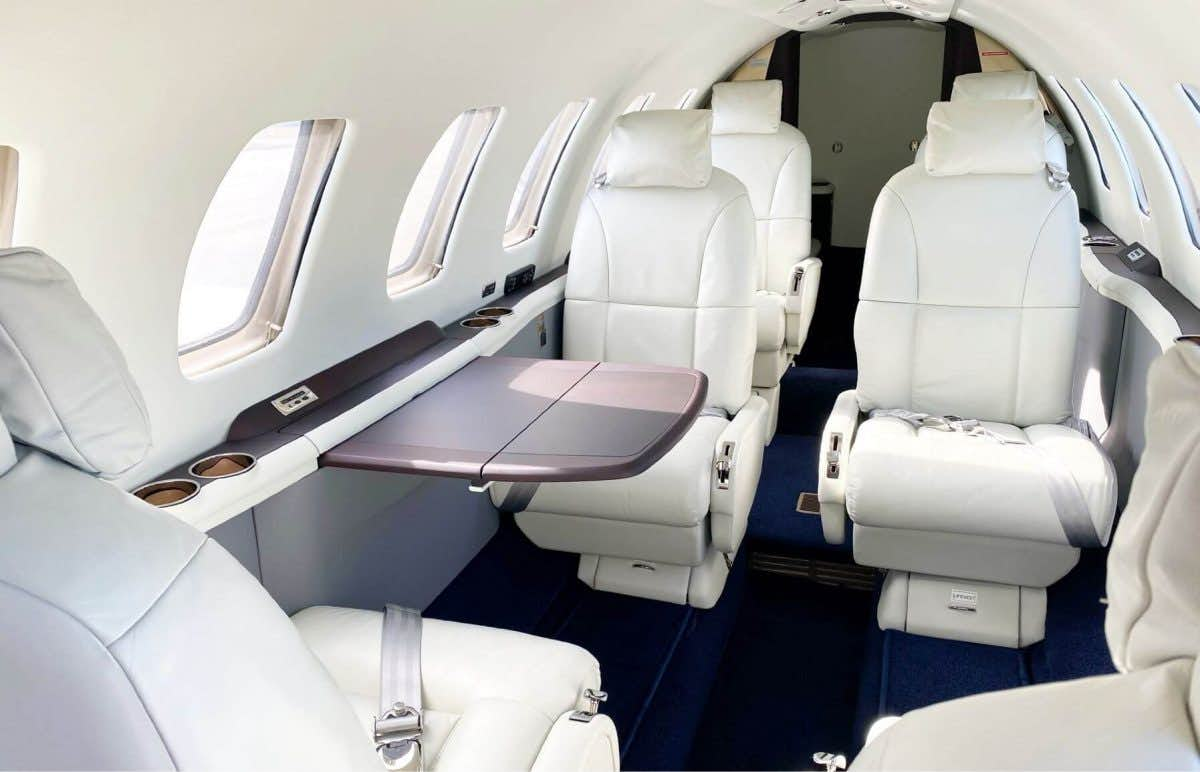
FlyExclusive clocked $88.1 million in Q1 revenues, and improved reliability as Adjusted EBITDA loss narrowed to $6.3 million.

FlyExclusive Q1 2025 revenue increased from $79.9 million to $88.1 million year-over-year, while cutting losses as Adjusted EBITDA loss decreased by nearly 70% to $6.3 million.
(You can download the 76-page Q1 10-Q SEC filing at the end of this story.)
Chairman and CEO Jim Segrave told earnings call listeners earlier today, “Last quarter, I spoke about the transformation of FlyExclusive throughout 2024. That transformation continues — and the benefits are now showing up across our operations, customer experience, and most importantly, financial results.”
He added, “We’ve modernized our fleet, strengthened our team, and streamlined our cost structure. Our partners — along with Jet Club and fractional members — are seeing the results in better aircraft, better service, and more reliability.”
FlyExclusive is the fifth-largest charter/fractional operator.
In addition to its retail customers, it is heavily used in the wholesale market for its nationwide floating fleet.
According to its Q1 financial filings, flight revenue increased from $76.1 million to $82.7 million year over year.
Aircraft Management Services generated $765,000, up from zero in Q1 2024.
MRO revenue grew year-over-year in Q1 to $1.8 million from $1.5 million.
Jet Club sales increased 25% compared to Q1.
The company recorded $16.2 million in fractional program activity, including $7.6 million in new fractional share sales and $8.6 million in fractional flight revenue.
That marked a 75% jump versus Q1 2024.
Regarding the bottom line, Segrave pointed to a nearly 70% year-over-year improvement in Adjusted EBITDA loss, from $19.4 million to $6.3 million.
Segrave said, “Compared to last year, SG&A was down 17%, and SG&A as a percent of revenue declined over seven points to roughly 24%. That seven-point improvement saved us over $6 million this quarter alone — or $24 million annually. We’ve built a more efficient and scalable public company infrastructure, and we expect SG&A to continue declining as a percentage of revenue. SG&A revenue per employee increased about 50% in 2024 and continues to rise in 2025.”
From its filing, the loss from operations was cut by nearly half, from $27.4 million to $14.7 million.
Net loss dropped from $32.9 million in Q1 2024 to $23.0 million.
According to its SEC filing:
‘A significant component of the Company’s operating losses and working capital deficit resulted from increased general and administrative costs associated with becoming a public company at the end of December 2023. The Company expects to incur operating losses in the near term as the Company advances its fleet modernization and associated cost savings initiatives.’
FlyExclusive has been selling off older, underperforming aircraft.
At the same time, it has added new and recent vintage aircraft to its fleet.
It recently launched a new premium super-midsize jet card option based on its Challenger 300 and Challenger 350s entering its fleet.
Segrave told analysts:
‘At the start of 2024, as we have discussed in the past, we had 37 non-performing aircraft in the fleet. The older Gulfstreams were the biggest drag, followed by the Citation Encore and X fleets. Today, we only have one of the non-performing Gulfstreams left in the fleet, down from seven, and just two of the Encores remain, down from 11. We’ve eliminated half of the Citation X fleet and will wind down the remaining aircraft over the next 12 months as new Challengers come online. The negative impact from these non-performing aircraft has been reduced by approximately 80% — from a peak of over $3 million per month to less than $600,000 today. Over the next few quarters, we will fully eliminate this drag on our performance.’
Management previously said the aircraft exiting its fleet were unavailable nearly 70% of the time.
Segrave continued:
‘From an operational standpoint, these non-performing aircraft had a dispatch availability of around 30%. As we eliminated 23 of them, we improved our overall maintenance dispatch availability by nearly 100%, now reaching the low-60% range. As we finish removing the remaining aircraft, we expect continued gains. This is how we’ve delivered sustained growth in flight hours and revenue with approximately 17 fewer aircraft. We estimate the old fleet structure, at its peak, was costing us as much as $36 million per year.’
Segrave told the call that each 1% increase in dispatch reliability adds $3 million to its bottom line annually.
Speaking about what’s next, he said:
‘The addition of Challengers to the fleet — alongside our profitable Citation CJ3s and Excels — has had a major positive impact on performance. We now have five Challengers in operation, with a sixth on-site preparing to enter service this month. We expect to accelerate Challenger additions over the remainder of 2025. We anticipate the Challenger fleet will grow to 12–15 aircraft and represent as much as 30% of overall revenue by year-end — just over a year after introducing the first Challenger 350 — again speaking to how fast we are transforming the landscape. These aircraft are delivering dispatch availability in the 80% range, as projected, and with the sixth arriving this month, we’ve extended super-midsize access to our Jet Club members. Each Challenger should generate $8 to $10 million in annual revenue and deliver stronger margins than any other aircraft in our fleet.’
Combined with its Citation CJ3s light jets and XLS midsize aircraft, Segrave said, “The story is clear: our fleet is more reliable, more profitable, and better aligned to deliver what our customers want and expect.”
Two new XLS Gen2s are scheduled for delivery from Textron in the second half of 2025.
In terms of flying, Segrave says the company flew 17,333 hours in Q1, a 6% year-over-year increase despite 20% fewer aircraft.
Despite economic uncertainty, WingX and ARGUS data show private jet flight activity is up compared to 2024.
Segrave says of FlyExclusive, “What’s even more impressive is that this performance essentially matched Q4, which is always our busiest quarter, due to very high demand over the holidays.”
He noted, “We generated $88 million in Q1, up 10% year over year, again with nearly 20% fewer aircraft. Nothing speaks more clearly to our transformation than delivering more flight hours and revenue with far fewer aircraft. This performance has been driven by strong customer demand, better fleet utilization, and much higher aircraft availability.”
Despite a smaller active fleet, membership grew by 38% to 713 members.
Wholesale business increased as well, up 9% in the quarter.
However, Segrave says there is room to add more retail customers.
“Our member-to-aircraft ratio is now 12.8 — still the lowest in the industry of any of the major players — giving us ample runway to grow while continuing to deliver the service our customers expect,” he told analysts.
Segrave also said the company has not seen the impact of economic turmoil.
“Contrary to reports of weakening demand in both leisure and business travel, our Q1 2025 retail charter activity was up 10%, and April was up 15% year over year,” he said.
He added, “Engagement from new and existing members continues to grow, and utilization trends remain strong.”
However, there is a trend to staying in the U.S.
“While our customer base isn’t overly sensitive to interest rates or currency fluctuations, we are seeing a modest shift from international to domestic travel,” Segrave noted.
Concerns about tariffs and trade policy have slowed some aircraft and fractional purchases.”
“Customer confidence continues to rise each day,” Segrave says.
The passing of 100% bonus depreciation, which is included in President Donald Trump’s Big Beautiful Bill, could help.
Segrave says the tax benefit would likely spur “conversions (of fractional ownership leads) to accelerate as the year progresses.”
In terms of cost impact, Segrave says the company’s vertical integration “gives us control over quality, cost, and uptime. If the industry faces bottlenecks, we believe we’ll be in a stronger position than most, ready to capture market share and serve our customers without disruption.”
The February announcement of merging Jet.AI’s aviation business is expected to close in 60 days.
Segrave also said, “We’re optimistic that we’ll be included in the Russell 2000 in the coming weeks. We now meet all qualification criteria. While inclusion is never guaranteed, we’ve checked every box to reach that milestone.”
The company is now “shelf-eligible and plans to file an S-3 shelf registration on or around June 2.”
It will provide access to additional funds to accelerate aircraft acquisitions.
Segrave noted, “Just as important, the funds we expect to raise will further solidify our liquidity, reduce leverage, improve cash flow, and eliminate our warrant overhang.”
At the end of Q1, cash and cash equivalents were $14.7 million, up from $5.3 million year-over-year.
DOWNLOAD: FlyExclusive-Q1-2025-Financials